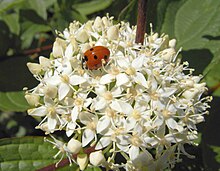Species
Cornaceae
IUCN
NCBI
EOL Text
Trees or shrubs. Leaves opposite, simple; margin entire or serrate. Stipules 0. Flowers bisexual (Curtisia) or unisexual (Afrocrania), actinomorphic, arranged in panicles (Curtisia) or in dense terminal clusters surrounded by 4 herbaceous bracts (Afrocrania); pedicels not articulated. Petals 4-5. Stamens equal in number and alternating with them. Ovary inferior, 2- or 4-locular. Fruit a drupe.
| License | http://creativecommons.org/licenses/by-nc/3.0/ |
| Rights holder/Author | Mark Hyde, Bart Wursten, Petra Ballings, Flora of Zimbabwe |
| Source | http://www.zimbabweflora.co.zw/speciesdata/family.php?family_id=63 |
Trees or shrubs. Leaves alternate, simple; margin entire to slightly undulate. Stipules 0. Flowers bisexual, actinomorphic, in few-flowered axillary cymes, with articulated pedicels. Calyx minutely toothed. Petals 4-10, valvate, linear, becoming recurved. Stamens equal in number to petals and alternating with them, hairy at the base. Ovary inferior, usually 1-locular. Fruit ribbed when dry, bearing disk and sepals at apex.
| License | http://creativecommons.org/licenses/by-nc/3.0/ |
| Rights holder/Author | Mark Hyde, Bart Wursten, Petra Ballings, Flora of Zimbabwe |
| Source | http://www.zimbabweflora.co.zw/speciesdata/family.php?family_id=4 |
Barcode of Life Data Systems (BOLD) Stats
Specimen Records:675
Specimens with Sequences:970
Specimens with Barcodes:665
Species:106
Species With Barcodes:105
Public Records:392
Public Species:89
Public BINs:0
Cornaceae (the dogwood family) is a cosmopolitan family of flowering plants in the order Cornales. It contains approximately 110 species, mostly trees and shrubs, which may be deciduous or evergreen. Members of this family usually have opposite or alternate simple leaves, four- or five-parted flowers clustered in inflorescences or pseudanthia, and drupaceous fruits.[1] In northern temperate areas, Cornaceae is well known from two genera: Cornus, the dogwoods, and Nyssa, the tupelos.
The systematics of Cornaceae have been remarkably unsettled and controversial, and many genera have been added to it and removed from it over time. (One researcher called it a "dustbin."[2]) Molecular phylogenetics have clarified the relatedness of some associated genera, and at least nine genera that were previously included in Cornaceae have been eliminated from the order Cornales entirely,[3] but the circumscription of Cornaceae is still unclear. The Angiosperm Phylogeny Group usually defines Cornaceae as comprising the genera Cornus and Alangium as well as the five genera often separated into the family Nyssaceae. However, many of these genera are sometimes split off into their own families (e.g. Alangiaceae), and the usage remains inconsistent.[3][4]
References
- ^ Kubitzki, K. (2004). Cornaceae. In The Families and Genera of Vascular Plants Volume 6: Flowering Plants: Dicotyledons: Celastrales, Oxidales, Rosales, Cornales, Ericales (Kubitzki, ed.). Springer-Verlag, New York.
- ^ Eyde, R. H. (1988). Comprehending Cornus - puzzles and progress in the systematics of the dogwoods. Botanical Review 54, 233-351.
- ^ a b Fan, C. Z., and Xiang, Q. Y. (2003). Phylogenetic analyses of Cornales based on 26S rRNA and combined 26S rDNA-matK-rbcL sequence data. American Journal of Botany 90, 1357-1372.
- ^ APG III (2009). An update of the Angiosperm Phylogeny Group classification for the orders and families of flowering plants. Botanical Journal of the Linnean Society 161, 105-121.
| License | http://creativecommons.org/licenses/by-sa/3.0/ |
| Rights holder/Author | Wikipedia |
| Source | http://en.wikipedia.org/w/index.php?title=Cornaceae&oldid=489303063 |
